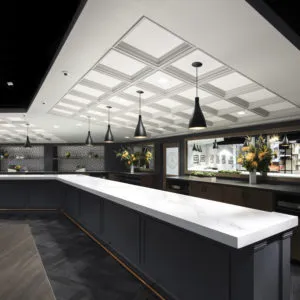Table of Contents
Growing cannabis industry among businesses that breathe new life into retail, laminate use
Yes, we all know that retail isn’t what it used to be, but brick-and-mortar stores still play a valuable role in helping consumers see, touch and try on products before they make purchasing decisions. This issue of Surface & Panel features prime examples of retailers and physical stores that continue to succeed by attracting shoppers.
As they always have, these stores need fixtures to display their goods, and the vast majority of those fixtures include composite panels, decorative surfaces and other materials supplied by the industries that we serve. Sure, some big names may have closed up shop, but plenty more are growing and continually building out their new stores or remodeling their existing ones.
Amid that reality involving traditional companies, new and innovative businesses are popping up in big numbers, selling emerging products in ways that we likely wouldn’t have imagined just a decade or two ago.
Take the cannabis industry. Greg James, publisher of Marijuana Venture, laid out the current and future growth in stores selling marijuana-related products in a column for Retail Environments magazine earlier this year.
“With Michigan recently added to the list of U.S. states with legal adult-use marijuana, the growth of cannabis retail stores is likely to accelerate yet again,” James said. “Currently, Washington, Oregon, Arkansas, California, Colorado and Nevada have approximately 2,000 retail locations up and running, with another 5,000 projected to open in California in 2019 and 2020.”
The old stereotype of a smoky head shop with Bob Marley posters on the walls is a thing of the past, he noted.
“Today’s cannabis retailers are often sophisticated, well-lit, modern stores that use technology and smart marketing techniques to attract ‘soccer moms’ and well-heeled shoppers from the suburbs. Some of the more sophisticated and popular locations are generating revenues well in excess of $1 million per month,” James said.
One prime example is The Apothecarium shops in San Francisco, which are profiled in a story that begins on page 32. These high-end stores are welcoming and attractive—even elegant. And all three of the shops feature high pressure laminate in their custom millwork, cabinets and shelving.
“Faux wood laminates are easy to care for and offer a more dynamic texture while adding to the atmosphere and blending in seamlessly with the other fine furnishings,” said Chase Chambers, director of operations.
In researching retail innovations for possible stories in this issue, I was also struck by the proliferation of multi-purpose cafés and shops designed around their primary purpose of selling cellphones. Twenty years ago, who would have imagined how our culture would revolve around phones and how many immersive retail outlets would pop up to sell them. Undoubtedly, laminates are key materials in many of these shops, and they will be increasingly specified as more of them are built in years to come.
In other words, all is far from doom and gloom when it comes to retail prospects and how they might affect the composite panel and decorative surfaces industries. Besides the historically steady customers, cannabis and cellphones are but two examples of business categories that grew from literally nothing just a few years or decades ago and established significant retail footings. Surely, more are already emerging, and many more will grow before our eyes in years to come.






